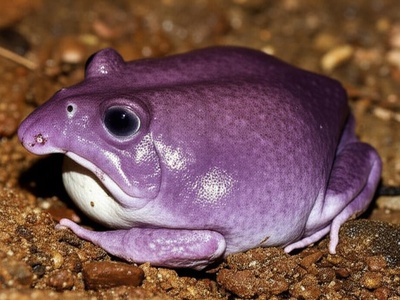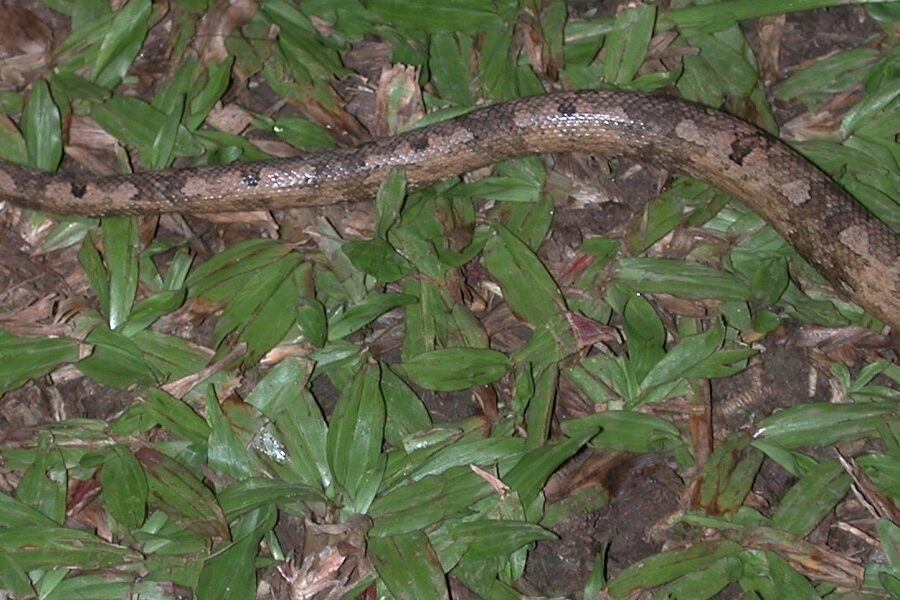In shaded streams, leaf litter and underground burrows, color can tell you a lot about an amphibian’s habits and history. Some species carry uncommon hues that hint at specialized lifestyles or isolated ranges, drawing interest from researchers and nature lovers alike.
There are 2 purple amphibians, ranging from Bhupathy’s Purple Frog to Splash-backed Poison Frog (‘Grape’ Morph). For each, you’ll find below Nasikabatrachus sahyadrensis,Dark, purplish-gray skin coloration from which it gets its common name.,Western Ghats mountain range in India.,A unique, bloated-looking fossorial frog with a small head and pointed snout. It spends most of its life underground, emerging for only a few weeks to breed. Its unusual appearance and subterranean lifestyle make it a fascinating and rarely seen species, discovered in 2003 — you’ll find below.
Where can I see these purple amphibians in the wild?
Bhupathy’s Purple Frog is known from the Western Ghats of India and is fossorial, so sightings are rare and usually confined to the brief breeding season; the Splash-backed Poison Frog (‘Grape’ Morph) occurs in different forested habitats where local guides or targeted surveys are the best way to observe them without disturbance.
Are these purple amphibians at risk and what protections exist?
Many narrowly distributed or secretive amphibians face habitat loss and other threats; conservation status varies by species, so check the IUCN Red List and local protections for up-to-date status and guidance on reporting observations or supporting habitat conservation.
Purple Amphibians
| Purple Frog | Nasikabatrachus sahyadrensis | Dark, purplish-gray skin coloration from which it gets its common name. | Western Ghats mountain range in India. | A unique, bloated-looking fossorial frog with a small head and pointed snout. It spends most of its life underground, emerging for only a few weeks to breed. Its unusual appearance and subterranean lifestyle make it a fascinating and rarely seen species, discovered in 2003. |
|---|---|---|---|---|
| Bhupathy’s Purple Frog | Nasikabatrachus bhupathi | A uniform grayish-purple skin, similar to its more famous relative. | Western Ghats mountain range in India. | A second species of purple frog discovered in 2017, closely resembling *N. sahyadrensis*. Like its relative, it has a robust body, a pointy snout for digging, and lives almost entirely underground. This species is named in honor of the late herpetologist Dr. S. Bhupathy. |
| Splash-backed Poison Frog (‘Grape’ Morph) | Adelphobates galactonotus | A captive-bred color morph with vibrant, solid purple or violet coloration. | Captive-bred; wild populations are found in the Amazon basin of Brazil. | This small dart frog is popular in the pet trade due to its striking colors. While wild forms are typically orange, yellow, or red, the ‘Grape’ morph has been selectively bred for a stunning, uniform purple color, showcasing the genetic diversity within the species. |
Images and Descriptions

Bhupathy’s Purple Frog
A second species of purple frog discovered in 2017, closely resembling *N. sahyadrensis*. Like its relative, it has a robust body, a pointy snout for digging, and lives almost entirely underground. This species is named in honor of the late herpetologist Dr. S. Bhupathy.

Splash-backed Poison Frog (‘Grape’ Morph)
This small dart frog is popular in the pet trade due to its striking colors. While wild forms are typically orange, yellow, or red, the ‘Grape’ morph has been selectively bred for a stunning, uniform purple color, showcasing the genetic diversity within the species.





